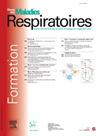Impact of specialized pro-resolving lipid mediators on the colonization of CF respiratory epithelia by aspergillus fumigatus
IF 0.5
4区 医学
Q4 RESPIRATORY SYSTEM
引用次数: 0
Abstract
Introduction
Inflammation is normally self-regulated by an active resolution phase, orchestrated by specialized pro-resolving mediators (SPMs) such as lipoxins (LX), resolvins (Rv), protectins (PD) and maresins. We recently showed that SPMs biosynthesis by airway epithelial cells is altered in cystic fibrosis (CF). CF is a genetic disease mainly characterized by airway chronic infection and excessive inflammation. Aspergillus fumigatus, a predominant filamentous fungus in CF is associated with lung injury and function decline. The consequences of the dysregulated SPMs biosynthesis on the colonization of the CF respiratory track by the filamentous fungi, A. fumigatus has not been investigated before this study.
Methods
We used human nasal epithelial primary cultures (hNEC) from CF and non-CF patients and the bronchial epithelial cell line (CFBE). We inoculated A. fumigatus (Af Dsred) conidia (MOI 1: 6.24 h) on epithelial cells grown on plastic or at air-liquid interface, treated or not with SPMs (10 nM). SPM receptors expression was studied by immunofluorescence. Fungal load was quantified by optical density using a microplate reader, by qPCR of gDNA, and using a galactomannan assay on the culture medium. Tight junctions were visualized using ZO-1 protein immunostaining. Antimicrobial peptides were explored using RTqPCR. The role of SPM receptors was evaluated using selective agonists and/or antagonists.
Results
On one hand, A. fumigatus infection for 24 h disrupted most of the airway epithelial tight junctions. When cells were treated with SPMs (LXA4, LXB4, RvE1, RvD5and PD1) simultaneously with A. fumigatus, the epithelial tight junction integrity was significantly protected. The SPMs’ protecting effect on tight junctions was observed up to 12 h after A. fumigatus exposure. The SPM protecting effect on tight junctions involved the G-protein coupled receptors, FPR2 (LXA4 and LXB4), GPR32 (RvD5and LXB4), ChemR23 (RvE1) and GPR37 (PD1) that we found to be expressed airway epithelial models. On the other hand, airway epithelium reduced A. fumigatus growth and secretion of one of its virulence factor galactomannan. The treatment of the airway epithelial cells with SPMs (LXA4, LXB4, RvE1, RvD2, RvD5, PD1) enhanced this latter effect with a further decrease of A. fumigatus galactomannan. Some SPMs as RvE1 stimulated the transcription of HBD2antimicrobial peptides.
Conclusion
Our results show that several SPMs stimulate the protecting role of epithelial cells in enhancing its barrier function. SPMs also reduce the secretion of galactomannan, which is an A. fumigatus virulence factor playing a critical role in biofilm formation. This suggests that the anomaly of SPMs biosynthesis in CF could significantly contribute to the reduced capacity of respiratory epithelial cells to protect themselves and to fight A. fumigatus. This study opens new therapeutic perspectives.
特异性促溶解脂质介质对烟曲霉在CF呼吸道上皮定殖的影响
炎症通常是由一个主动的消退阶段自我调节的,由专门的促消退介质(SPMs)如脂毒素(LX)、消退蛋白(Rv)、保护蛋白(PD)和蛋白(maresin)精心策划。我们最近发现,在囊性纤维化(CF)中,气道上皮细胞的SPMs生物合成发生了改变。CF是一种以气道慢性感染和过度炎症为主要特征的遗传性疾病。烟曲霉是CF中主要的丝状真菌,与肺损伤和功能下降有关。SPMs生物合成失调对丝状真菌(A. fumigatus)在CF呼吸道定植的影响在本研究之前尚未被研究过。方法采用CF和非CF患者鼻上皮原代培养(hNEC)和支气管上皮细胞系(CFBE)。将烟曲霉(afdsred)分生孢子(MOI 1:6 .24 h)接种于塑料或气液界面上生长的上皮细胞上,分别用SPMs (10 nM)处理和不处理。免疫荧光法检测SPM受体的表达。真菌负荷通过光密度定量,使用微孔板阅读器,通过gDNA的qPCR,并在培养基上使用半乳甘露聚糖测定。用ZO-1蛋白免疫染色观察紧密连接。采用RTqPCR技术检测抗菌肽。使用选择性激动剂和/或拮抗剂评估SPM受体的作用。结果烟曲霉感染24 h后,大部分气道上皮紧密连接被破坏。当SPMs (LXA4、LXB4、RvE1、rvd5和PD1)与烟曲霉同时作用于细胞时,上皮紧密连接的完整性得到了显著保护。暴露于烟曲霉12 h后,观察到SPMs对紧密连接的保护作用。SPM对紧密连接的保护作用涉及g蛋白偶联受体FPR2 (LXA4和LXB4)、GPR32 (rvd5和LXB4)、ChemR23 (RvE1)和GPR37 (PD1),我们发现这些受体在气道上皮模型中表达。另一方面,气道上皮减少烟曲霉的生长和其毒力因子半乳甘露聚糖的分泌。SPMs (LXA4, LXB4, RvE1, RvD2, RvD5, PD1)处理气道上皮细胞后一种作用增强,烟曲霉半乳甘露聚糖进一步减少。一些SPMs如RvE1刺激hbd2抗菌肽的转录。结论几种SPMs可刺激上皮细胞的保护作用,增强其屏障功能。SPMs还减少半乳甘露聚糖的分泌,半乳甘露聚糖是烟曲霉毒力因子,在生物膜形成中起关键作用。这表明,CF中SPMs生物合成的异常可能导致呼吸上皮细胞自我保护能力和对抗烟曲霉的能力下降。这项研究开辟了新的治疗前景。
本文章由计算机程序翻译,如有差异,请以英文原文为准。
求助全文
约1分钟内获得全文
求助全文
来源期刊

Revue des maladies respiratoires
医学-呼吸系统
CiteScore
1.10
自引率
16.70%
发文量
168
审稿时长
4-8 weeks
期刊介绍:
La Revue des Maladies Respiratoires est l''organe officiel d''expression scientifique de la Société de Pneumologie de Langue Française (SPLF). Il s''agit d''un média professionnel francophone, à vocation internationale et accessible ici.
La Revue des Maladies Respiratoires est un outil de formation professionnelle post-universitaire pour l''ensemble de la communauté pneumologique francophone. Elle publie sur son site différentes variétés d''articles scientifiques concernant la Pneumologie :
- Editoriaux,
- Articles originaux,
- Revues générales,
- Articles de synthèses,
- Recommandations d''experts et textes de consensus,
- Séries thématiques,
- Cas cliniques,
- Articles « images et diagnostics »,
- Fiches techniques,
- Lettres à la rédaction.
 求助内容:
求助内容: 应助结果提醒方式:
应助结果提醒方式:


